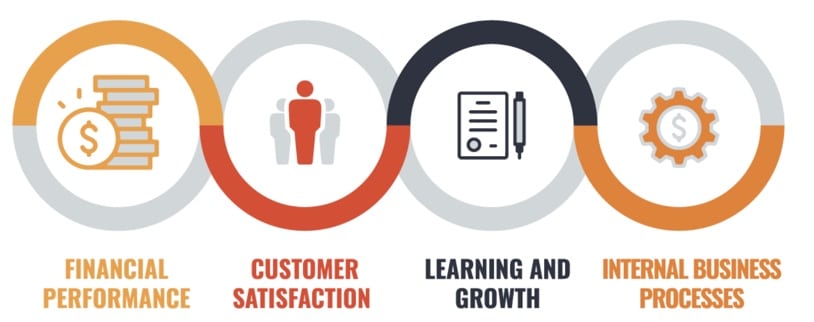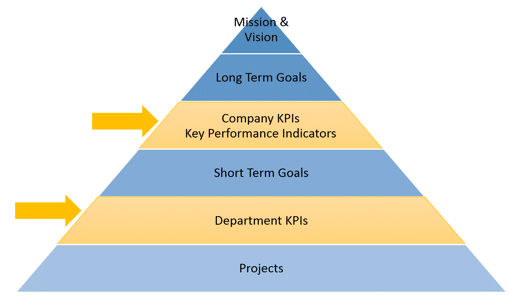The who, what, when, where, why, and how of Balanced Scorecards.
Why is it important?
What comes to mind when you hear the word balance? For most people the answer will be something like: equal, stable, fair. You think of balance as putting the same amount of effort into each important area of your life so that they all will flourish. When life is balanced it gives us a sense of calm and security.
When it is not balanced, we can feel guilty, anxious, unhappy. Even if one area of our life is booming with success; if that is the only area we are focusing on, there’s a good chance the other important areas of our lives are suffering.
The same is true of your company’s balance, and this is where the Balanced Scorecard method comes in.
What is it?
The Balanced Scorecard is a comprehensive strategy that ensures a business doesn’t focus too much on one area of their business while other equally important areas suffer. No one wants to focus so much on making money that they miss the fact they are destroying employee morale. Likewise, no one wants to find that they have focused too much on driving throughput that it lessened the quality of their work or their products. This is why the balance created by the Balanced Scorecard is so important.
What should I be focusing on?
Financial Performance | Customer Satisfaction | Learning and Growth | Internal Business Processes
There are 4 key aspects of your business that you should never ignore. They are:
- Financial Performance.
- Customer Satisfaction.
- Learning and Growth.
- Internal Business Processes.
Where do I start?
So far we’ve learned about the why, we know the what. Here is the how, and the where.
Where do I start? You start right where you are in this moment.
Whether you are a Fortune 500 Company or you are a newer, smaller start up; there is always room for improvement. Everyone needs to start somewhere, and the only correct answer is: right here!
Ask yourself this question, “how will we measure our performance in each key area of our business AND ensure they align with our highest level strategic goals?” The answer is, “you have to create actionable key performance indicators (KPIs/metrics) for each of the 4 most important areas of your business. You should already have a head start creating financial KPIs; they are common and well understood in most industries. Companies usually struggle when determining KPIs for the other important areas that they are not used to tracking very close, if at all.
More about Actionable KPIs
The term Actionable KPI is critical because a metric should be linked to a strategic objective and be something we can change through process improvement. The diagram below gives you an idea of how your company’s Mission and Vision should be broken down each year into long term goals, then short term goals, and finally projects with a layer of KPIs governing each layer of strategy.
A well designed and executed strategic plan will align your team, their thoughts, motivations, and actions toward a common goal.
The table below gives an example of how KPIs might be created. Determining which KPIs should be measured is important and should be done as a team with the leaders of each department and process involved.
| KPI | Balanced Scorecard | Leading KPI | Lagging KPI |
| Sales | Financial | X | X |
| Material Costs | Financial | X | |
| Labor Costs | Financial | X | |
| Customer Satisfaction | Customer | X | |
| Customer Touches | Customer | X | |
| Product Returns | Customer | X | |
| Product Returns | Financial | X | |
| Product Returns | Business Processes | X | |
| Blog Posts | Customer / Financial | X | |
| Throughput | Business Processes | X | |
| Changeover Time | Customer | X | |
| Employee Satisfaction | Learning & Growth | X | |
| Employees in continuing education program | Learning & Growth | X | |
| Kaizen Events Completed | Learning & Growth / Business Processes | X |
Making KPIs and Balanced Scorecard Work Together:
KPIs can sometimes break the rules of the Balanced Scorecard. Notice how “Product Returns” crosses into multiple Balanced Scorecard categories. Product returns are a leading indicator for Customer Satisfaction. If returns go up you can logically assume that your Customer Satisfaction score next month will go down. On the other hand, product returns is a lagging indicator for Business Processes. If your quality starts to drop off in June your customer returns will go up in July. Understanding the difference between leading and lagging indicators is crucial to your business. If you can determine which KPIs correlate to your lagging indicators you can predict many of your metrics before you see the shift. You can also prevent problems from happening… or forecast a huge improvement in sales based on improvements you’ve made to leading KPIs. Either way knowing the relationship is going to help you better manage your business and achieve your goals.
Who can help with ALL of these items?
WE CAN! We are The KPI Fire Team, and we would love to help you begin using Balanced Scorecard right away.
Why should you use KPI Fire to facilitate your Balanced Scorecard Strategy?
KPI Fire facilitates strategic planning workshops that help leaders create a clear vision for the future of their company and a roadmap to execute the plan. If you’re interested in learning how KPI Fire can you reach your goals contact our CEO personally at keith.norris@54.201.12.32
When should you reach out?
NOW!
Call now +1(855)957-4347 and we will provide a free consultation and help you set up your free trial. Or email keith.norris@54.201.12.32 and I will personally ensure you receive the help you need as soon as possible.
Several of our customers here at KPI Fire use a popular approach to their annual strategic plan and we thought we’d share it with you. (Watch the video here.)






